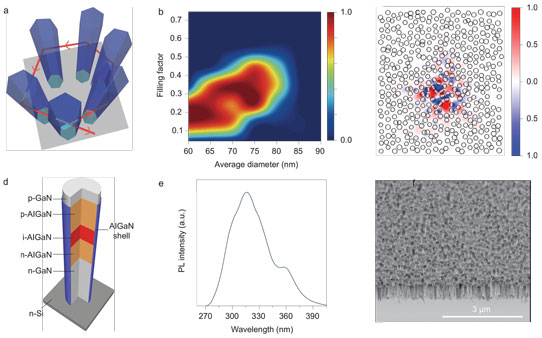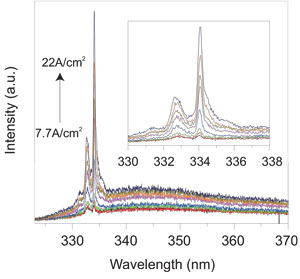- News
4 February 2015
Ultraviolet random AlGaN nanowire array lasers
Researchers at McGill University in Canada have claimed the shortest wavelengths ever reported for any electrically injected semiconductor laser [K. H. Li et al, Nature Nanotechnology, published online 19 January 2015]. The devices were based on disordered aluminium gallium nitride (AlGaN) nanowire arrays grown on silicon using plasma-assisted molecular beam epitaxy (PAMBE) without using metal catalysts.
The researchers see a lithography-free process for fabricating defect-free nanowire array lasers on large-area silicon substrates as having potential for low cost scalable and controllable processing of ultralow-power-consumption ultraviolet (UV) devices. With further tuning of the nanowire parameters, ultralow-threshold nanowire lasers across the entire UV-A (400nm-315nm), -B (315nm-280nm) and -C (280nm-100nm) spectral ranges could be developed for biochemical purification and analysis, sensing, communication and lighting applications.

Figure 1: a, Schematic formation of closed-loop photon path inside AlGaN nanowire arrays on which Anderson localization is based. b, Probability of forming high-Q cavity versus filling factors and diameters of nanowires. c, Simulation showing profile of electric field for high-Q cavity. d, Schematic of AlGaN nanowire double-heterostructure. e, Photoluminescence spectrum at room temperature. f, A 45° tilted SEM of nanowire arrays grown on silicon substrate.
Two-dimensional simulations based on the idea of 'Anderson localization' suggested that high-Q (quality factor) cavities could be created with high probability by arrays of 70nm-75nm diameter wires with filling factors of ~30% (Figure 1). Anderson localization refers to a mechanism for confining waves (electromagnetic, acoustic, electron, etc) where there is a large quantity of randomness provided by defects, impurities and such like. The McGill simulations suggested that random cavities with Q factors of 20,000 could be achieved for UV-AII light of ~330nm wavelength.
Vertical confinement was provided by designing double heterostructures within the AlGaN nanowires with 50nm undoped active material sandwiched between 150nm p-type and n-type cladding regions. The active region had ~30% Al content, while the cladding had 56% Al. The wires were grown on an n-GaN template on (111) n-Si substrates. The structure was finished off with a ~25nm p-GaN top contact layer.
The researchers performed "extensive growth optimization" to achieve the design requirements of nanowire diameter and filling factor. The laser diodes were produced by filling the gaps between the wires with polyimide, etching back to reveal the p-contact, mesa etching for the n-contact, and deposition and annealing of metal contacts.
Electroluminescence measurements at 6K showed two sharp peaks above the background at 332.7nm and 334.1nm (Figure 2). The 334.1nm peak was dominant, with a lasing threshold of ~12A/cm2. The line-width was as small as 0.2nm at threshold. The researchers say that the threshold is nearly three orders of magnitude lower than for previously reported GaN-based UV lasers.
 Figure 2: Electroluminescence emission spectra measured at 6K under different current densities. Inset: enlarged view of lasing spectra. Integrated intensity.
Figure 2: Electroluminescence emission spectra measured at 6K under different current densities. Inset: enlarged view of lasing spectra. Integrated intensity.
At 30A/cm2 injection current the output power was ~2μW. Stability of the lasing wavelengths at up to 6x the threshold current suggested to the researchers that "the lasing emission is dominated by the extremely stable excitonic transition rather than by the emission related to electron–hole plasma." (Excitons are often modeled as electron-hole bound states.)
The researchers add: "The ultralow threshold is attributed to the high-Q optical resonance, the nearly defect-free AlGaN nanowires, the drastically reduced non-radiative surface recombination offered by the AlGaN core–shell structures and possibly the strong quantum-confinement effect related to the nanometric compositional fluctuations of the active region."
Increasing the temperature to 100K caused the peaks to red-shift by~0.7nm. This is thought to be due to shrinkage of the AlGaN bandgap in the active region and a shift of the refractive index in the random cavity.
Ultraviolet lasers AlGaN nanowire array lasers AlGaN PAMBE GaN
http://dx.doi.org/10.1038/nnano.2014.308
The author Mike Cooke is a freelance technology journalist who has worked in the semiconductor and advanced technology sectors since 1997.


